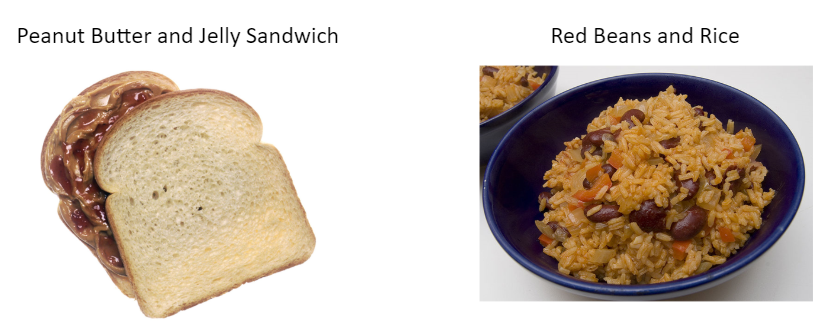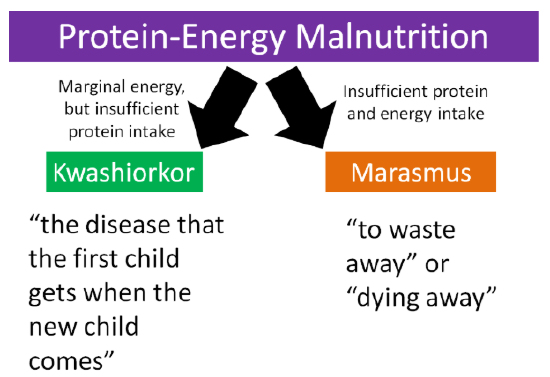2.4: Protein Quality and Protein-Energy Malnutrition
- Page ID
- 41606
Protein Quality
Proteins can be classified as either complete or incomplete. Complete proteins provide adequate amounts of all nine essential amino acids. Animal proteins such as meat, fish, milk, and eggs are good examples of complete proteins. Incomplete proteins do not contain adequate amounts of one or more of the essential amino acids. For example, if a protein doesn't provide enough of the essential amino acid leucine it would be considered incomplete. Leucine would be referred to as the limiting amino acid, because there is not enough of it for the protein to be complete. Most plant foods are incomplete proteins, with a few exceptions such as soy. The table below shows the limiting amino acids in some plant foods.
| Food | Limiting Amino Acid(s) |
|---|---|
| Bean and Most Legumes | Methionine, Tryptophan |
| Tree Nuts and Seeds | Methionine, Lysine |
| Grains | Lysine |
| Vegetables | Methionine, Lysine |
Complementary Proteins
Even though most plant foods do not contain complete proteins, it does not mean that they should be sworn off as protein sources. It is possible to pair foods containing incomplete proteins with different limiting amino acids to provide adequate amounts of the essential amino acids. These two proteins are called complementary proteins, because they supply the amino acid(s) missing in the other protein. A simple analogy would be that of a 4 piece puzzle. If one person has 2 pieces of a puzzle, and another person has 2 remaining pieces, neither of them have a complete puzzle. But when they are combined, the two individuals create a complete puzzle.

Two examples of complementary proteins are shown below.

It should be noted that complementary proteins do not need to be consumed at the same time or meal. It is currently recommended that essential amino acids be met on a daily basis, meaning that if a grain is consumed at one meal, a legume could be consumed at a later meal, and the proteins would still complement one another35.
Measures of Protein Quality
How do you know the quality of the protein in the food you consume? The protein quality of most foods has been determined by one of the methods below.
- Biological Value (BV) - (Grams of nitrogen retained / grams of nitrogen absorbed) x 100
- Protein Efficiency Ratio (PER) - Grams of weight gained / grams of protein consumed. This method is commonly performed in growing rats.
- Amino Acid Score (AAS) - Test food limiting essential amino acid (mg/g protein) / needs of same essential amino acid (mg/g protein). An amino acid score of 100 or more indicates that the protein contains adequate amounts of all essential amino acids and thus is considered complete. An amino acid score of less than 100 indicates that at least 1 amino acid is limiting and it is incomplete.
- Protein Digestibility Corrected Amino Acid Score (PDCAAS) - Amino Acid Score x Digestibility
This is the most widely used method and was preferred by the Food and Agriculture Organization and World Health Organization (WHO) until recently36,37.
The following table shows the protein quality measures for some common foods.
| Protein | PER | Digestibility | AAS (%) | PDCAAS |
|---|---|---|---|---|
| Egg | 3.8 | 98 | 121 | 100* |
| Milk | 3.1 | 95 | 127 | 100* |
| Beef | 2.9 | 98 | 94 | 92 |
| Soy | 2.1 | 95 | 96 | 91 |
| Wheat | 1.5 | 91 | 47 | 42 |
*PDCAAS scores are truncated (cut off) at 100. These egg and milk scores are actually 118 and 121 respectively.
The Food and Agricultural Organization (FAO) recently recommended that PDCAAS be replaced with a new measure of protein quality, the Digestible Indispensable Amino Acid Score (DIAAS). “DIAAS is defined as: DIAAS % = 100 x (mg of digestible dietary indispensable amino acid in 1g of dietary protein / mg of the same dietary indispensable amino acid in 1g of the reference protein).” Ileal digestibility should be utilized to determine the digestibility in DIAAS; ideally in humans, but if not possible in growing pigs or rats37.
The main differences between DIAAS and PDCAAS are that DIAAS:
- Takes into account individual amino acids’ digestibility rather than protein digestibility. The DIAAS focus can be on the limiting amino acid to provide a better indicator in the quality of that protein.
- Focuses on ileal instead of fecal (total) digestibility. Ileal digestibility is a more accurate measure of protein digestibility/bioavailability since this is the end of the small intestine, where amino acid uptake/absorption occurs.
- Has 3 different reference patterns (different age groups, 0-6 months, 6 months-3 years, 3-10 years old) instead of a single reference pattern. This allows for better matching or meeting the needs of different groups.
- Are not truncated38. Not truncating is viewed as being more accurate when comparing proteins.
Protein-Energy Malnutrition
Protein deficiency rarely occurs alone. Instead it is often coupled with insufficient energy intake. As a result, the condition is called protein-energy malnutrition (PEM). This condition is not common in the U.S., but is more prevalent in less developed countries. Kwashiorkor and marasmus are the two forms of protein energy malnutrition. They differ in the severity of energy deficiency as shown in the figure below.

Kwashiorkor is a Ghanaian word that means "the disease that the first child gets when the new child comes39." The characteristic symptom of kwashiorkor is a swollen abdomen. Energy intake could be adequate, but protein consumption is too low.

Marasmus means "to waste away" or "dying away", and thus occurs in individuals who have inadequate protein and energy intakes.

References
- en.Wikipedia.org/wiki/File:Pe...mationball.svg
- http://www.genome.gov/Glossary/index.cfm?id=149
- www.genome.gov/Pages/Hyperion...essenger%20RNA
- en.Wikipedia.org/wiki/File:Pr...nsynthesis.png
- "225 Peptide Bond-01" by OpenStax College - Anatomy & Physiology, Connexions Web site. http://cnx.org/content/col11496/1.6/, Jun 19, 2013.. Licensed under CC BY 3.0 via Commons - commons.wikimedia.org/wiki/F...de_Bond-01.jpg
- en.Wikipedia.org/wiki/File:Co...riplehelix.png
- en.Wikipedia.org/wiki/File:In...it_diagram.svg
- en.Wikipedia.org/wiki/File:Il...irculation.jpg
- Anonymous. Dietary Reference Intakes for Energy, Carbohydrate, Fiber, Fat, Fatty Acids, Cholesterol, Protein, and Amino Acids (Macronutrients). Protein and Amino Acids. Institute of Medicine, Food and Nutrition Board. 2005 http://books.nap.edu/openbook.php?re...10490&page=589
- en.Wikipedia.org/wiki/Phenyl...nylalanine.svg
- en.Wikipedia.org/wiki/Tyrosi...L-Tyrosine.svg
- en.Wikipedia.org/wiki/Histid..._Histidine.svg
- en.Wikipedia.org/wiki/Isoleu...Isoleucine.svg
- en.Wikipedia.org/wiki/Leucin...e_Nonionic.svg
- en.Wikipedia.org/wiki/Lysine...D-skeletal.png
- en.Wikipedia.org/wiki/Methio...Methionine.svg
- en.Wikipedia.org/wiki/Phenyl...nylalanine.svg
- en.Wikipedia.org/wiki/Threon...eonineasdf.png
- en.Wikipedia.org/wiki/Trypto...Tryptophan.svg
- en.Wikipedia.org/wiki/Valine...notatpH7.4.png
- en.Wikipedia.org/wiki/Argini...-_Arginine.svg
- en.Wikipedia.org/wiki/Cystei...L-Cysteine.svg
- en.Wikipedia.org/wiki/Glutam...-Glutamine.svg
- en.Wikipedia.org/wiki/Glycin..._-_Glycine.svg
- en.Wikipedia.org/wiki/Prolin..._-_Proline.svg
- en.Wikipedia.org/wiki/Tyrosi...L-Tyrosine.svg
- en.Wikipedia.org/wiki/Alanin..._L-Alanine.svg
- en.Wikipedia.org/wiki/Aspara...Asparagine.svg
- en.Wikipedia.org/wiki/Aspart...tic_Acidph.png
- en.Wikipedia.org/wiki/Glutam..._Non-ionic.png
- en.Wikipedia.org/wiki/Serine...-_L-Serine.svg
- Wardlaw GM, Hampl J. (2006) Perspectives in nutrition. New York, NY: McGraw-Hill.
- commons.wikimedia.org/wiki/F...y_sandwich.jpg
- en.Wikipedia.org/wiki/File:Re...s_and_rice.jpg
- Young VR, Pellett PL. (1994) Plant proteins in relation to human protein and amino acid nutrition. Am J Clin Nutr. May; 59 (5 Suppl): 1203S-1212S.
- Schaafsma G. (2000) The protein digestibility-corrected amino acid score. J Nutr 130(7): 1865S-1867S.
- www.fao.org/ag/humannutrition...04ffc17f06.pdf
- Rutherford SM, Fanning AC, Miller BJ, Moughan PJ. Protein Digestibility-Corrected Amino Acid Scores and Digestible Indispensable Amino Acid Scores Differentially Describe Protein Quality in Growing Male Rats. J Nutr. 145(2): 372-379.
- Byrd-Bredbenner C, Moe G, Beshgetoor D, Berning J. (2009) Wardlaw's perspectives in nutrition. New York, NY: McGraw-Hill.
- en.Wikipedia.org/wiki/File:Starved_girl.jpg
- en.Wikipedia.org/wiki/File:Starved_child.jpg


